|
80x5 -
240x3 -
240x4 -
320x1 -
320x2 -
320x3 -
640x1 -
640x2
Set display option above.
Click on
images to enlarge. |
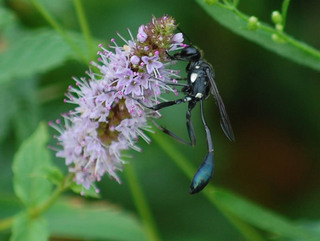
© Copyright Sheryl Pollock 2011
· 7
Eremnophila aureonotata, Thread-waisted Wasp |
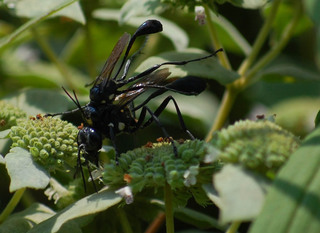
© Copyright Sheryl Pollock 2011
· 5
Eremnophila aureonotata, Solitary Wasps |
|
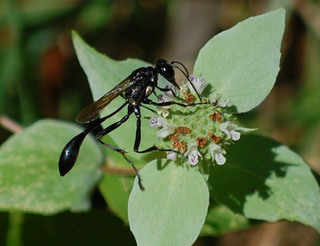
© Copyright Sheryl Pollock 2011
· 5
Eremnophila aureonotata, Thin-waisted Wasp |
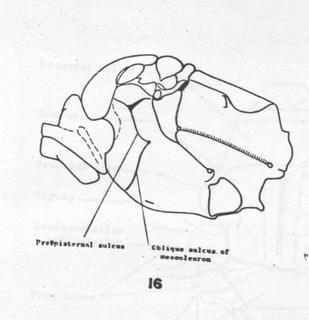
Arnold S. E. Menke, 1965 · 1
Eremnophila aureonotata, thorax |
|
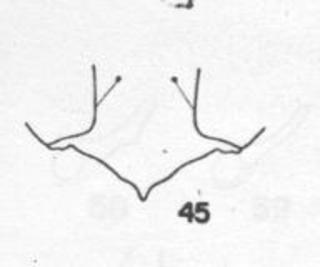
Arnold S. E. Menke, 1965 · 1
Eremnophila aureonotata, male, clypeus |
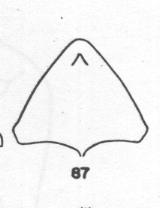
Arnold S. E. Menke, 1965 · 1
Eremnophila aureonotata, 8th sternite |
|
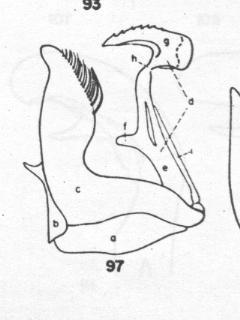
Arnold S. E. Menke, 1965 · 1
Eremnophila aureonotata, genitalia |
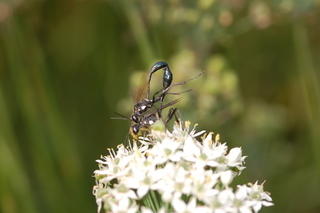
© John Pickering, 2004-2023
· 1
Eremnophila aureonotata |
|
Overview |
Taken from: A Revision of the North American Ammophila (hymenoptera, Sphecidae). Arnold S. E. Menke, 1965.
Ammophila (Eremnophila) aureonotata Cameron
(figs. 16, 45, 87, 97)
Ammophila aureonotata Cameron, 1888. Biologia Centrali-Americana, Hymen. 2:7. Lectotype male, Valladolid, Yucatan, Mexico (British Museum, London), designated by Menke, 1964.
Ammophila abbreviata of authors, not Fabricius.
Ammophila gracilis of authors, not Lepeletier.
The characters of the subgenus readily separate aureonotata from all other North American Ammophila. The distinctive aedeagus is shown in figure 97. A. aureonotata occurs throughout the United States and southern Canada east of the Rocky Mountains. The species occurs along the east coast of Mexico to the Isthmus of Tehuantepec and thence south to El Salvador.
Ammophila binodis Group
Diagnosis. Primary characters: Hypostoma in male with a thumb-like process near mandible base; penis valve head flexibly united with penis valve stalk, stalk with a ventromedian projection (fig. 97); subgenital plate (gastral sternite VII) with a subapical process (figs. 87, 97). Secondary characters: Mesopleuron with a triangular spot appressed silver hair; propodeal side with a spot of appressed silver hair anterior to propodeal spiracle and also adjacent to petiole socket; erect body hair pale except for psammophore in some females; free margin of male clypeus acuminate, triangular in outline (fig. 45), apex often produced into a long process; propodeal enclosure coarsely transversely ridged or irregularly rugose medially; enclosure finely, closely diagonally ridged laterally; metapleural flange not lamellate or only narrowly so.
Included North American species. Ammophila aureonotata Cameron. Neotropical species in the group are: binodis (Fabricius), catamarcensis Schrottky, and willinki Menke.
Discussion. The subapical process on the subgenital plate, the structure of the aedeagus and the thumb-like projection of the hypostoma in the male are distinctive features of the binodis group. The Neotropical species in this group are South American but one, binodis, ranges into Panama. See Menke (1964c) for further systematics of the group.
Ammophila subgenus Eremnophila
Diagnosis. Primary characters: PreŽpisternal sulcus curving to scrobe and ending there; mesopleuron with an oblique sulcus which extends from scrobe to anterior mesosternal area (fig. 16); penis valve of aedeagus divided into an apical head and a basal stalk, the two parts flexibly joined (fig. 97) (except in melanaria Dahlbom). Secondary characters: Clypeus, frons and pronotal lobe covered with dense appressed silver or golden hair, female clypeus glabrous anteromedially; male clypeus acuminate (except in auromaculata Perez); base of gonoforceps prolonged dorsoventrally with stalk of aedeagus attached at the dorsal end (fig. 97).
Range. Eremnophila is primarily a Neotropical group. One species however occurs in eastern North America.
Discussion. Menke (1964c) recognized two species groups in Eremnophila: the binodis group and the eximia group. Two species, melanaria Dahlbom and opulenta Querin-Meneville, were not placed in either group, and probably each should be considered as a monotypic group. The binodis group has one representative in North America.
|
|
|
Names | |
|
|
| Supported by | |
Updated: 2024-04-25 17:07:11 gmt
|